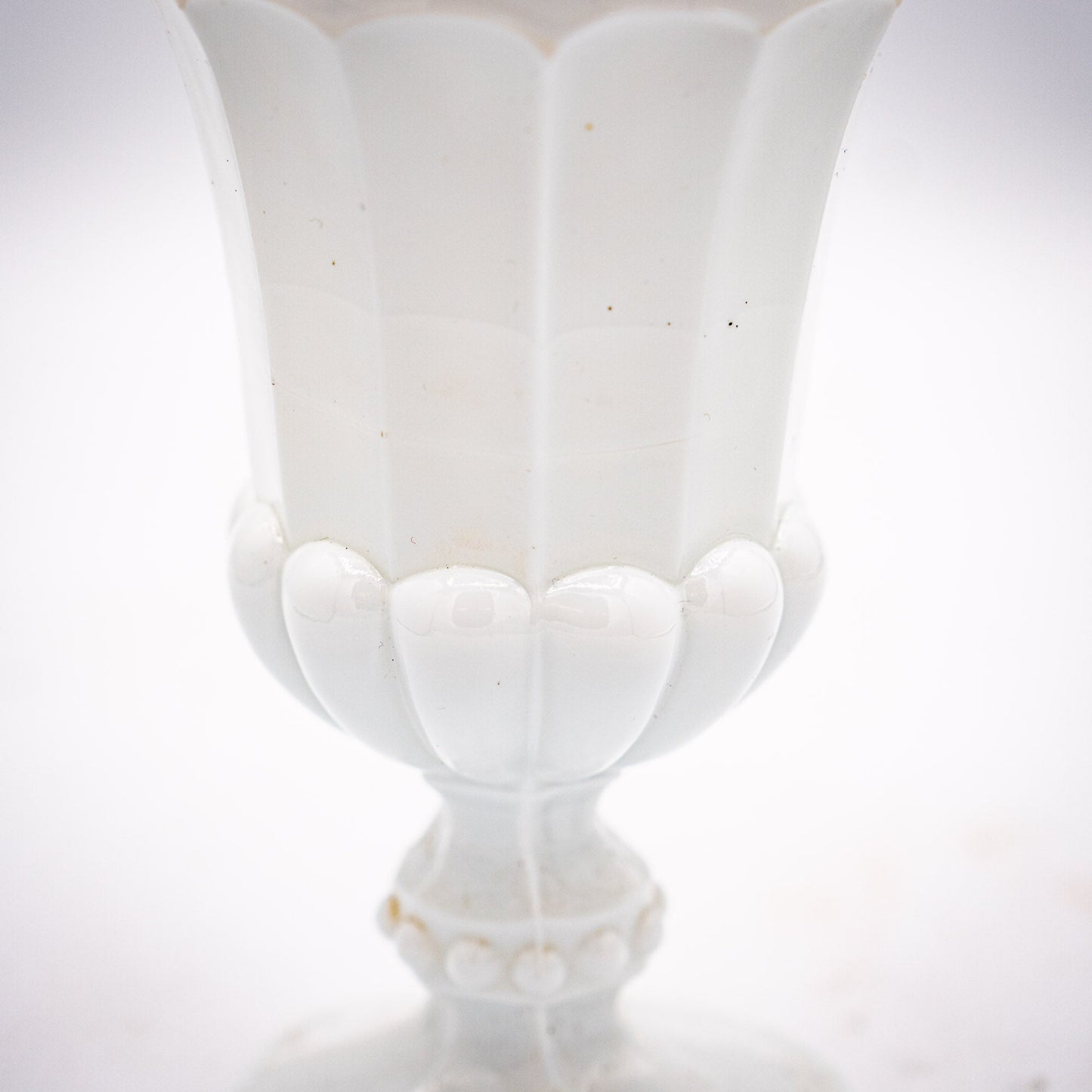Portieux Vallérysthal
French Opaline Chalice Vase (Lobed & Beaded) – 1910s
French Opaline Chalice Vase (Lobed & Beaded) – 1910s
Couldn't load pickup availability
A graceful early 20th-century French opaline chalice with a lobed cup, beaded knop, and scalloped foot. The cool, luminous white typical of opaline glass makes this a lovely statement on a mantel, in a cabinet, or used as a petite posy vase.
French opaline enjoyed a golden age in the mid-19th century, prized for its soft, porcelain-like glow and elegant forms. This hand-finished chalice captures that look: a gently flared, panel-lobed cup rises from a baluster stem ringed with tiny “pearl” beads and finishes on a quatrefoil foot. Subtle tool marks, tiny air bubbles and slight tonal variations in the glass are all hallmarks of period opaline production and add to the charm.
Perfect for a single bloom, makeup brushes, or as a pretty accent among ironstone and faïence.
- Material: Opaline (opaque “milk” glass)
- Maker: Unmarked (atelier in France)
- Motif: Lobed panels, beaded knop, scalloped/quatrefoil foot
- Style: Second Empire to Belle Époque; neoclassical revival
- Place of Origin: France
- Mark: Unmarked (typical for the period)
- Date of Manufacture: c.1860–1880
-
Condition: Good antique condition with expected signs of age: light surface wear, scattered tiny air bubbles, a few specks/production impurities, and faint tool lines from manufacture. No cracks; presents beautifully.
Share
- Worldwide Shipping
- Secure Packaging
- Loving Curation





Origin & Maker
Rich in tradition and steeped in history, Vallerysthal is synonymous with exceptional glassmaking.
Its story began in 1707 when Duke Léopold of Lorraine authorised a glassworks at Plaine de Walsch, near the area now known as Vallérysthal. By the early 19th century, the region’s glass was celebrated for its quality, with innovations like the half-crystal and double-coloured, cut glass perfected under M. de Fontenay in 1833. In 1830, the glassworks relocated to Val de Valléry, taking its name from Baron Valléry, and evolved into the renowned Verrerie de Vallérysthal.
The 1872 merger with Verreries de Portieux further enriched the tradition, blending the skills of master glassmakers. Today, with over three centuries of heritage, the glassworks of Vallérysthal and Portieux continue to enchant collectors, combining ancestral craftsmanship with modern techniques.
Blog posts
View all-

A Serendipitous Morning at the Rue de Bretagne ...
There are few joys in life that match the thrill of stumbling upon a hidden treasure, and for me, flea markets hold that magical allure. One of my favourite flea...
A Serendipitous Morning at the Rue de Bretagne ...
There are few joys in life that match the thrill of stumbling upon a hidden treasure, and for me, flea markets hold that magical allure. One of my favourite flea...
-

Emile Bourgeois and "Le Grand Dépôt" in Paris
Recently, I found this stunning Sarreguemines wash set. It was at the Brocante in Belfort, France. On this day, we had got up at 4 AM to be there in...
Emile Bourgeois and "Le Grand Dépôt" in Paris
Recently, I found this stunning Sarreguemines wash set. It was at the Brocante in Belfort, France. On this day, we had got up at 4 AM to be there in...
-

The Legacy of Robert Haviland: A Journey from N...
The story of Robert Haviland porcelain is one of artistry, transatlantic ambition, and enduring heritage. It begins in the mid-19th century when David Haviland, an enterprising New Yorker, founded Haviland...
The Legacy of Robert Haviland: A Journey from N...
The story of Robert Haviland porcelain is one of artistry, transatlantic ambition, and enduring heritage. It begins in the mid-19th century when David Haviland, an enterprising New Yorker, founded Haviland...








